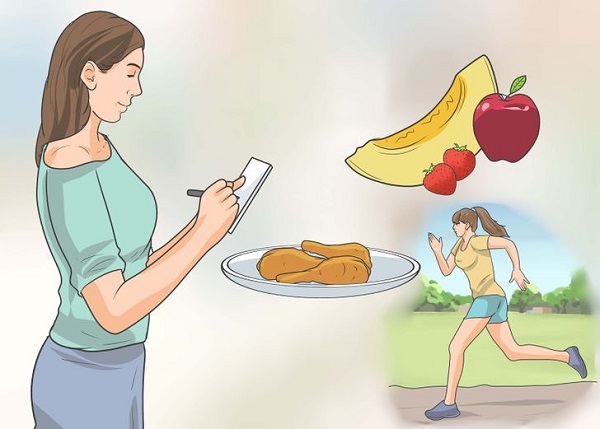You can still have desserts if you have diabetes, you just have to be smart about it. A few strategies can help you include sweet treats in a healthy diet.
A small amount of weight loss can lower your risk for many health conditions.
Just losing 5% to 10% of your body weight can make a huge difference. You do not need to worry about all of your food choices, but you should focus on the carbohydrates you consume. A Mediterranean or other heart-healthy diet can help you achieve this, but the most important thing you can do is to lose a little weight.
Losing 5% to 10% of your total weight can also help you lower your blood sugar, blood pressure, and cholesterol levels. Eating healthier can also have a profound effect on your mood, energy, and sense of wellbeing.
People with diabetes have a greater risk of developing heart disease and mental health disorders such as depression.
It is much healthier to eat moderate amounts of food more often, especially if you are trying to keep your blood sugar level steady, as with diabetes.
An “all-or-nothing” mentality to cut out all baked goods, is not only a miserable way to go about your day, but it is also likely to backfire. By following these tips, you can still enjoy the occasional baked treat without it adversely affecting your diabetes.
1. Trade Unhealthy Sources of Fat for Healthy Ones
Unfortunately, butter is high in saturated fat, which people with diabetes need to limit.
The AHA states that high amounts of saturated fat can lead to an increased risk of heart disease.
Diabetes increases the likelihood of developing heart disease by more than double, according to the Centers for Disease Control and Prevention (CDC).
Instead of using butter, which is high in unhealthy saturated fat, try using healthier fats like:
- Olive Oil
- Canola Oil
- Avocado Oil
These oils are much better for your heart and won’t increase your cholesterol levels like butter will.
The ADA states that monounsaturated and polyunsaturated fats that lower LDL cholesterol levels are beneficial for reducing the risk of heart disease.
If you would rather not use oil in your cooking, try using mashed avocado, pumpkin puree, Greek yogurt, or nut butter instead.
2. Get Creative with Natural Sweeteners
There are better options for people with diabetes than table sugar. This means that for every 1 cup of baking sugar, you can use 1 cup of unsweetened applesauce or mashed bananas.
Baked goods can contain vitamins, minerals and fiber. Fiber helps to prevent blood sugar levels from rising too quickly.
Honey and maple syrup can be used as substitutes for table sugar, but not in equal amounts. They are also not as good for people with diabetes as unsweetened applesauce or bananas.
To substitute honey for sugar in a recipe, use half to two-thirds as much honey as sugar, and for every 1 cup of honey used, reduce the amount of liquid in the recipe by a quarter-cup and add half a teaspoon of baking soda.
You should use two-thirds to three-quarters of a cup of maple syrup for every 1 cup of sugar if you want the maple syrup to work best in the recipe. You should also subtract 3 to 4 tablespoons of liquid.
Although honey and maple syrup are natural sugars, they can still cause blood sugar levels to rise. Although they don’t cause blood sugar to rise as quickly, they have the benefit of providing antioxidants like flavonoids and phenolic acids.
3. Experiment with Sugar Substitutes
There are a variety of artificial sweeteners that can be used in baking for those with diabetes, such as stevia, monk fruit, and sugar alcohols like xylitol or erythritol.
Where can I find these? You can find them in liquid, granule, or powder forms. There are now a wide variety of alternative sugars located in your local grocery next to the bagged granulated white sugar.
A sugar or carbohydrate substitution like applesauce, bananas, or honey is not necessary with artificial sweeteners. Although artificial sweeteners have some benefits, there are also some disadvantages. For example, they may change the taste slightly, and baked goods may not brown as much because there’s no sugar to caramelize.
This can cause problems for treats like sugar cookies. Weisenberger therefore recommends combining sugar with a suitable alternative.
Some recipes just won’t work out using a full sugar substitute. Sugar cookies are a good example. You can experiment with a 1/2 and 1/2 method. Half sugar half sugar substitute.
If you are looking to cut down on sugar, try using a sugar alternative in place of sugar. You can use half a cup of sugar and half a cup of the sugar alternative, or two-thirds of a cup of the sugar alternative.
You should still be careful about how much you eat of baked goods made with sugar alternatives, because eating too much of them can cause stomach problems.
4. Try Alternative Baking Flours
If you want to add more fiber to your baked goods, you can swap out the all-purpose flour for whole-wheat flour. This will add 6 grams of fiber per half cup. Fiber can help slow the absorption of sugar, which is beneficial for people with diabetes.
There are other types of flour available to experiment with, like almond flour or coconut flour.
Almond flour has the lowest amount of carbohydrates, followed by coconut flour, says Lori Zanini, RD, CDCES, author of the Diabetes Cookbook and Meal Plan for the Newly Diagnosed, based in Manhattan Beach, California.
Use caution when using these flours as they are high in fat despite being low in carbs.
Diets rich in fat can lead to insulin sensitivity. The ADA says that insulin resistance (a reduced ability to process insulin) is a common symptom of type 2 diabetes.
Approximately half a cup of almond flour contains 16 grams of fat, as estimated by the United States Department of Agriculture. This is in contrast to half a cup of all-purpose flour, which contains only approximately 3 grams of fat.
A half a cup of King Arthur coconut flour contains 12 g of fat, all of which is saturated fat.
There is a significantly higher amount of fat in both all-purpose and self-rising flour in comparison to whole-wheat flour.
Increase your daily fiber intake with a delicious supplement Purium’s Daily Fiber Organic – Caramel Apple!
5. Use Dark Chocolate or Unsweetened Cocoa Powder
You should opt for dark and unsweetened varieties instead of white or milk chocolate whenever you can.
Dark chocolate provides helpful antioxidants, specifically flavonols. Flavonols are associated with a reduced risk of heart disease and high blood pressure, as noted by the AHA.
The findings from a small study suggest that dark chocolate may offer benefits specifically for people with type 2 diabetes. Researchers found that study participants with type 2 diabetes who ate around one ounce of dark chocolate every day for eight weeks saw improvements in fasting blood sugar and A1C levels.
Although people with type 2 diabetes saw no improvements from eating white chocolate, those who ate an equal amount of dark chocolate saw significant improvements.
The Harvard T.H. Chan School of Public Health advises choosing chocolate that contains at least 70 percent cacao for maximum health benefits.
If you want to make your cookies extra chocolatey, try using mini chocolate chips in place of standard-sized ones. Using three-quarters of a cup of mini chocolate chips instead of 1 cup of standard-sized chocolate chips will do the trick. This is a way to reduce the amount of chocolate (read: added sugar and calories) in a recipe without feeling deprived. It does not seem like less because there are many dots of chocolate in the cookies.
6. Be Smart About Sweets
A diabetic diet does not necessarily mean eliminating sugar, but rather, consuming sugar in moderation like most people should. If you have diabetes, you can still enjoy your favorite desserts occasionally. The key is to not overindulge.
You can reduced your sugar intake gradually over time, so that your cravings for sweets decrease. This will give your taste buds time to adjust to the new level of sugar.
If you want to eat dessert, then hold back on the other carb-heavy foods such as bread, rice, or pasta. This is because eating sweets at a meal adds extra carbohydrates.
Adding fat to your dessert will help to slow down the digestive process and prevent your blood sugar levels from spiking too quickly.
You should eat sweets as part of a meal, not as a snack. Eating sweets by themselves will cause your blood sugar to go up, but if you eat them with other healthy food as part of your meal, it won’t go up as much.
When you eat dessert, take the time to savor each bite. Don’t just mindlessly eat your way through a bag of cookies or a huge piece of cake. Make sure you’re actually enjoying each bite.
If you want to make your indulgence worthwhile, take your time to savor the flavors and textures. You’ll get more enjoyment out of it this way, and you’re less likely to overeat.
7. Tricks For Cutting Down On Sugar
By reducing the amount of soft drinks, soda, and juice you consume each day, you can help lower your risk for diabetes.
If you want to consume fewer calories, you can replace sugary drinks with sparkling water that has been flavored with lemon or lime. You should also use less cream and sugar in your coffee and tea.
The problem is that when we swap saturated fat for sugar, we end up eating more overall calories. You shouldn’t replace saturated fat with sugar. A lot of us replace foods that are high in saturated fat, like whole milk dairy, with refined carbs because we think it’s a healthier choice. The issue is that when we swap saturated fat for sugar, we end up consuming more calories in general.
Just because a product is low in fat, that doesn’t mean it’s healthy if sugar has been added to make up for the lost flavor.
It’s better to add sweetener to food yourself rather than buy products that are already sweetened. This way you can control how much sugar goes into your food.
Read the labels on food products and choose those with less sugar. Use fresh or frozen foods instead of canned items. Pay attention to the amount of sugar in cereals and sugar-sweetened beverages.
Processed and packaged foods often contain hidden sugar, so it’s best to avoid them. Prepare more meals at home instead.
If you want to reduce the amount of sugar in your recipes, you can replace it with mint, cinnamon, nutmeg, or vanilla extract. These ingredients will add sweetness to your dish without the need for sugar.
There are healthy ways to enjoy sweets without damaging your health. One way is to blend up frozen bananas for a creamy, frozen treat. Another way is to have a small chunk of dark chocolate instead of a milk chocolate bar.
Instead of eating the whole dessert, eat half of it and replace the other half with fruit.
8. Spot Hidden Sugar
You also need to consider other foods such as those high in saturated and trans fats. It’s not enough to just be careful with sugary foods – you also need to watch out for other types of food that are high in unhealthy fats like saturated and trans fats.
Are you trying to cut back on sugar but finding it difficult? You’re not alone. Sugar is hiding in many foods that you might not expect. It’s found in packaged foods, fast food meals, and even some grocery store staples likes bread and cereals. Other places you might find sugar include pasta sauce, margarine, instant mashed potatoes, frozen dinners, low-fat meals, and even ketchup.
The first step is to spot hidden sugar on food labels, which can take some sleuthing:
- Manufacturers provide the total amount of sugar on their labels but do not have to differentiate between added sugar and sugar that is naturally in the food.
- Added sugars are listed in the ingredients but aren’t always easily recognizable as such. While sugar, honey, or molasses are easy enough to spot, added sugar could also be listed as corn sweetener, high-fructose corn syrup, evaporated cane juice, agave nectar, cane crystals, invert sugar, or any kind of fructose, dextrose, lactose, maltose, or syrup.
- While you’d expect sugary foods to have sugar listed near the top of their list of ingredients, manufacturers often use different types of added sugars which then appear scattered down the list. But all these little doses of different sweeteners can add up to a lot of extra sugar and empty calories!
Final notes
Get More Active
You can also try a moderate-intensity activity like jogging or swimming for 30 minutes a day. Exercising can help you both manage your weight, and improve your sensitivity to insulin. A simple way to start getting exercise is to walk for 30 minutes each day (or three 10-minute segments if that’s easier for you). You can also try a moderate-intensity activity, such as jogging or swimming, for 30 minutes each day.
READ MORE: Diabetic Retinopathy









